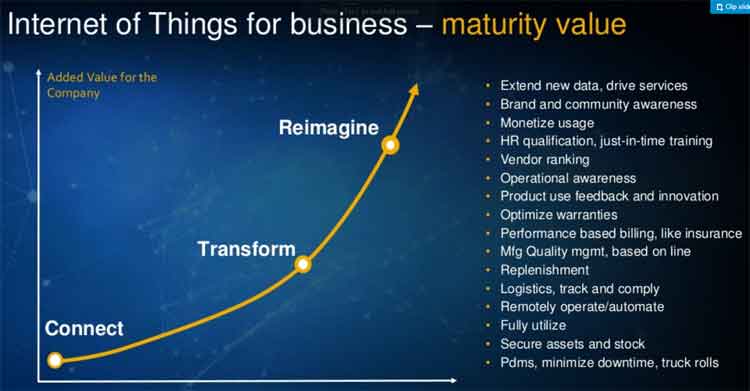Software giant SAP is investing major dollars in Internet of Things (IoT) capabilities, adding new software applications organically and making several acquisitions to expand its IoT software offerings.
SAP is taking this effort in multiple directions. It is releasing capabilities that will be able to support customers who are already using IoT-based systems, and is working on a future wave of SAP IoT solutions.
Supply Chain Digest Says... |
 |
| It is clear we are moving towards a world in which everything is in the supply chain is visible all the time, a vision first embraced in the early days of RFID in the early 2000s. |
 |
What do you say? |
| Click here to send us your comments |
 |
| Click here to see reader feedback |
|
|
The company recently said it is currently seeing three kinds of key application areas for IoT software:
• Industrial customers which use or sell heavy equipment and are seeking to optimize operations cost, maintenance cost and response times.
• Generation of aftermarket insights for sold products, so businessescan receive digital feedback to improve designs and create better engagement with customers.
• Solutions for customers with large moving assets such as fleets, cars, trucks, which can use IoT to track and trace this equipment in real-time.
While potential customers in the first category are currently most prevalent in the oil, gas, chemical and mining sectors, SAP believes interest is also growing in agriculture, healthcare, and the financial industry within the next year.
For example, it is working on new solutions in the insurance sector, where it is building the capability to track the vehicle usage so that customized insurance quotes can be created – in other words, how you drive will directly impact your insurance rates.
In September, SAP announced plans to invest a whopping $2.25 billion in the development of its IoT capabilities in its software over the next few years.
Multiple IoT Acquisitions
In August, SAP announced the acquisition of Norwegian company Fedem Technology AS, which brought to SAP deep domain expertise and proprietary software that performs IoT data analysis.
Fedem can build a "digital clone" of a machine or set of machines, then collect sensor data from the physical structure in the Cloud, analyze the data real-time and provide a snapshot of the equipment's condition.
SAP says it plans to build these capabilities into its next generation end-to-end IoT solutions for predictive maintenance as well as real-time structural integrity monitoring and Industry 4.0 scenarios. The goal is to provide customers a detailed picture of the state of equipment, vehicles or plant operations, and thus provide the capability to conduct proactive or preventative maintenance, reducing downtime.
SAP also recently announced the acquisition of Plat.One, developer of a platform used for creating, deploying and managing IoT applications, especially large scale implementations.
With the acquisition, SAP says it will be able to better integrate its IoT capabilities, including device lifecycle management and IoT edge capabilities, into its HANA Cloud Platform.
(See More Below)
|
CATEGORY SPONSOR: SOFTEON |
|
|
| |
|
|
Finally, SAP also recently announced the acquisition of Palo Alto, CA,-based Altiscale, which provides Cloud-based versions of the Hadoop and Spark open source software for advance analytics. While the acquisition will help SAP strengthen its "Big Data"
solutions generally, it also plans to leverage the new capabilities in other initiatives, including IoT.
But SAP is hardly just focused on only acquisitions in terms of its IoT strategies.

Source: SAP
Earlier this month, it released SAP Connected Goods, a Cloud-based solution delivered on SAP HANA Cloud Platform designed to generate actionable insights from IoT data from mass-market "things," everything from coolers to vending machines to power tools, using remote monitoring, management and (where appropriate) central control.
SAP says this solution optimizes device availability, utilization and performance, and can better optimize stock levels and storage details. It can also identify relevant trends and usage patterns. It is said to use rules-based alerts for inventory replenishment of goods and provide customizable dashboards.
SAP has also released what it calls Dynamic Edge Processing, which it says is a platform that supports real-time IoT decision-making, and optimizes operations by enabling "edge"
assets (things directly employed in supply chain processes and thus an entry point for system data) and workers to operate more efficiently. It provides a series of capabilities for managing, storing and forwarding IoT data, the company says.
So between acquisitions and product releases, that is quite a lot of IoT investment from SAP. It is clear we are moving towards a world in which everything is in the supply chain is visible all the time, a vision first embraced in the early days of RFID in the early 2000s but which never really saw fruition.
But it may really be different this time around with IoT.
What do you think of SAP's focus on IoT? Smart strategy, or unlikely to pay off? What will this always-on world of data mean for supply chain? Let us know your thoughts at the Feedback button below.
Your Comments/Feedback
|